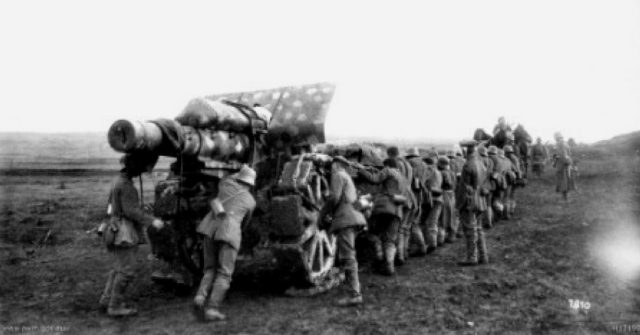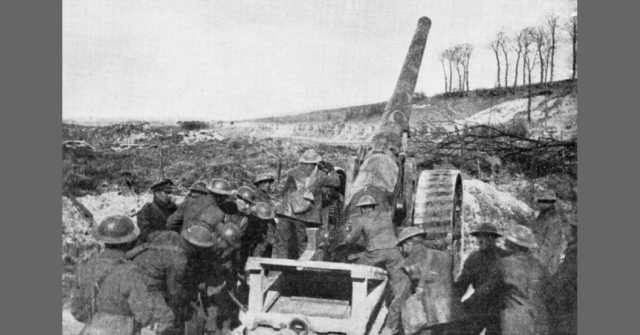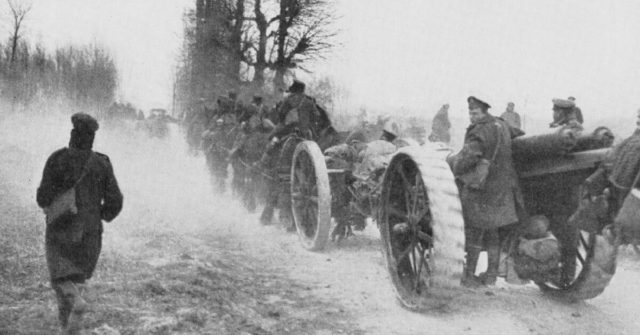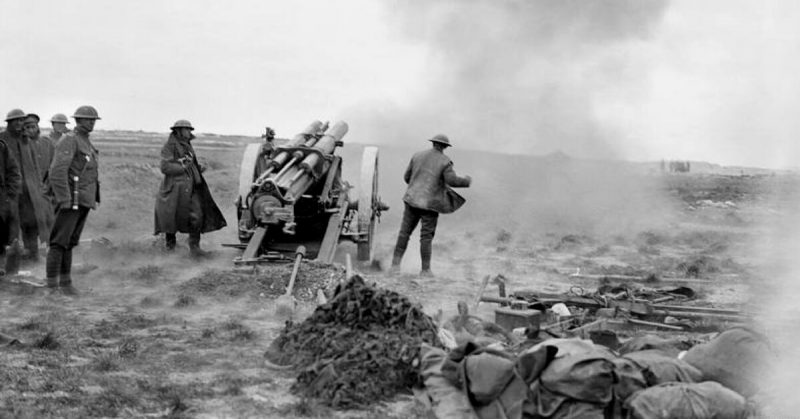By the spring of 1918, the Western Front of the First World War had been almost static for three years. Then the Germans, intent on breaking the deadlock while they could, launched an operation to break through the Allied lines.
The first of what became five offensives was called Operation Michael.
The Need to Act
Two factors drove the Germans to launch their offensive.
From early in the war, the German strategy had been to endure and hold out on the Western Front while they won the battle on the Eastern Front. They focused on building strong defensive positions, with deep dugouts and well-constructed trenches. With these, they could hold off the British, French, Belgian, and colonial troops. Once they defeated the Russians, they could then bring the full weight of their armies to fight in the west.
However, it was not a military victory but the Russian Revolution that changed events. As Russia withdrew from the war, thousands of German soldiers were moved west. Instead of 150 divisions on the Western Front, by March 1918 they had 192.
The other critical factor was the entrance of America into the war. America had a pool of untapped manpower and immense industrial resources. Hundreds of thousands of well-equipped soldiers were coming to bolster the Allies.
If the Germans were to win the war, they needed to deliver a knockout blow before vast numbers of American troops arrived.

New Tactics
The Germans had developed two new tactics which would be crucial to Operation Michael.
The battlefield would be prepared by Colonel Georg Bruchmüller’s artillery tactic of the “fire-waltz.” Artillery had been necessary throughout the war and methods for its deployment had grown increasingly sophisticated. The fire-waltz was the latest idea, combining suppression of artillery with a front-line bombardment of mixed shells including high explosives, smoke, tear gas, and poison gas.
The other element was the infantry tactics of Captain Herman Geyer, set out in his influential 1918 book Der Angriff im Stellungskrieg – The Attack in Positional Warfare. They focused on the use of small elite units equipped with grenades and light machine guns. These Stormtroopers would break through enemy lines in swift, decisive attacks. Rather than try to defeat all the enemies in a sector they would bypass strongpoints, leaving them for follow-up troops. It would allow them to maintain momentum.
Day One
Operation Michael began at 0440 on March 21, 1918. The fire-waltz hit 43 miles of British lines, leaving the Allies uncertain where exactly the attack would commence. British artillerists, wearing gas masks and trying to aim through smoke, struggled to return fire.
After 0935, a creeping barrage began, advancing across no man’s land. The Stormtroopers set out behind the cover of the explosions, advancing swiftly on the British lines.
Beneath the devastating combination of fire-waltz and positional assault, the British lines collapsed. A few pockets of resistance stubbornly held on. Small, scattered, and without hope of reinforcement, one by one they fell. At 1400, orders were given to British troops to fight a delaying action while the big guns were pulled back. They were in full retreat.
By the end of the day, the Germans had suffered 40,000 casualties and inflicted 38,500 on the British. They had made some of the best advances of the war and shattered their opponents confidence.

Driving a Wedge
The aggressive assault continued the next day. The British carried on with their fighting withdrawal, but by the evening they feared the Germans might be about to drive a wedge between the Allied armies.
General Ludendorff was fostering such a plan. On March 23, he issued new orders. With the British collapsing, he thought the time for a breakthrough had come. The Sixth and Seventeenth armies would aim southward, to separate the British from the French. The British could then be dealt with alone while the French were driven southwest.
It was not to be. Without tanks and cavalry to get around their enemies, the Germans could not move faster than the British, and so could not get around their flank. The British could keep retreating, as the ground behind them lacked strategic assets. It had already been devastated by the war. Little of value remained before the railway through Amiens.
Amiens became the focus of the German push, to break the rail link between Paris and the sea.
Losing Impetus
The Germans kept up the attack, but they were losing momentum. The leading Stormtroopers were taking heavy casualties. It reduced their ability to make effective assaults. The speed of the advance became its undoing, as supply lines were stretched and vulnerable.
At Amiens, British Major-General George Carey commanded a makeshift group of units in preparation for the last line of defense.

Counter-Attack
Near Noyon, the British 2nd Cavalry Division dismounted to make a counter-attack in support of French forces. On April 4, 600 Australian and 400 British troops made another counter-attack near Villers-Brettoneux, a village on a ridge overlooking Amiens, which prevented the Germans from taking it. The same happened again on April 24 and 25, this time featuring the first tank versus tank battle in history.
Outcome and Aftermath
At last, Operation Michael ground to a halt. The British had incurred 178,000 men killed, injured, or captured. The French 77,000, and the Germans 239,000. The Allies had lost a lot of ground and armament resources. British industry, however, was working flat out to replace lost equipment, bolstered by American support.
Operation Michael was a promising start for the German spring offensive. In the end, it was symptomatic of a wider pattern; a strong initial push that could not be sustained, ending in bloody exhaustion.
Source:
Martin Marix Evans (2002), Over the Top: Great Battles of the First World War.
